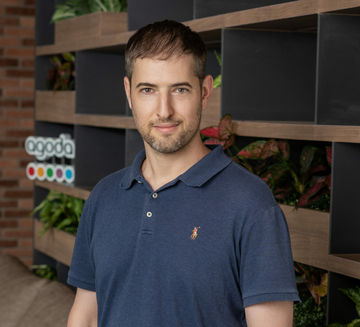The project began as something of a lark: Using generative artificial intelligence to create a children’s book about life at an online travel agency.
The story told of a girl’s journey to her mother’s office, where she is awed by the size of server rooms “that make sure people all around the world can book their holiday at the same time” and imagines the code her mother writes is a form of magic to protect users from the “bugs, dark wizards and ugly trolls” that threaten the software.
But when the team at Agoda released “Maya and the Secret World of Agoda” last November, it was clear the project was no joke. And though the project served no specific business purpose, it offers insight into how the company’s use of technology is integral to a decidedly human approach to serving travelers.
“I think Maya embodies the spirit of Agoda,” said Idan Zalzberg, Agoda’s chief technology officer since 2022. “We believe that a child’s curiosity, openness and sense of wonder are some of the most important qualities for us as humans and those are the traits we’re trying to nurture in Agoda’s culture too. The book was born from that same passion and curiosity.”
Subscribe to our newsletter below
Technology has always been a foundational priority at Agoda, no more so than since the ascent of Omri Morgenshtern as CEO two years ago. Mogenshtern and Zalzberg were co-founders of Qlika, which specialized in online marketing optimization and was acquired in 2014 by Booking Holdings. After the acquisition, the Qlika team transitioned to Agoda, which is headquartered in Singapore with operations in Bangkok, Thailand and was acquired by Booking Holdings in 2007.
In a far-ranging conversation with PhocusWire, Zalzberg went into detail about subjects ranging from how Agoda tests and refines technology in pursuit of its vision; its step-by-step approach to its use of AI; discovering unexpected uses for the technology; and even being mindful of how emphasizing fun provide a creative spark.
“Our vision is for Agoda to become more than just a transactional service. We aim to be a ‘travel companion’ that can notify you of changes, like weather conditions, and suggest alternatives when necessary,” Zalzberg said when asked about Agoda’s goals. “Travel is a wonderful experience, but it can sometimes go astray. Our goal is for Agoda to provide the sense that you have a capable expert traveling with you, supporting you every step of the way, no matter what happens.”
Technology is front and center to that effort, Zalzberg made clear in a conversation that has been lightly edited for clarity and brevity.
I have a lot of questions about tech and AI, but first I need to ask about Maya. Tell us how this project came to be.
It’s one of those things that really came out of nowhere, which makes it even greater. Some folks were toying with the idea of making a children’s book about Agoda and there was a lot of excitement internally to see what we could do with new Al technologies. Over time, more people got involved and pitched in, but it was never a business-oriented thing with specific goals and timelines. We just wanted to quench our curiosity and create something we could be proud of.
You said at the time you had more than 70 internal projects running in the tech department to leverage increasing efficiency. How do the lessons your team learns from fun projects like Maya help make you better at improving Agoda’s platform for its customers?
That number is above 100 now. We’re strong believers in learning and continuous improvement. Just because a project is “fun” doesn’t mean you can’t learn from it. Quite the opposite, actually — when you’re enjoying what you’re doing, you’re more focused. Even if you hit hardships, you won’t give up until you find a way around them. That’s why the concept of “play” exists in nature — it’s the best way to learn!
For generative Al projects in particular, we’ve found that they follow a similar cycle. It’s often pretty easy to create a basic prototype but very challenging to make it good enough for production. Ensuring the application consistently produces high-quality output can be tough, as the underlying technology is unpredictable. Developing techniques to handle that unpredictability took us quite a while.
Can you elaborate on the short- and medium-term planning you feel is crucial for making a difference with AI?
First, I recommend companies experiment with Al in various ways. About 18 months ago, we held a large hackathon with our entire developer team just to let people “get their hands dirty” with Al and develop an intuition for what’s possible. Once you have a grasp of the technology and its capabilities — Hint: It’s much more than just “chatbots”! — you can start identifying problems it can clearly help solve.
A common mistake I see is starting from the solution and looking for a problem. Good engineering always begins with understanding the problem. Generative Al opens so many new doors that it requires a re-evaluation of where technology can be helpful — you need to remap your problems to solutions. For example, scanning legal contracts for specific concerns at scale was something we wouldn’t have considered using technology for in the past, but now it’s possible.
We worked with all departments to map their problems to possible Al solutions and then prioritized them based on cost, confidence and impact. Interestingly, the most valuable use cases for GenAl often aren’t the ones you initially think of when you see online demos.
Unlike usual software, GenAl is inherently unpredictable. It’s often easy to create a “wow” demo, but much harder to develop something that consistently performs as expected. This requires significant effort and time to build robust testing and evaluation frameworks.
What do you see as the real value of AI in customer interfaces?
Customer interfaces with Al are tricky. It’s easy to assume that everything can be done with a chatbot, but it’s not that simple. Successful customer interfaces are ones that clearly present the information needed and provide the functions required with minimal effort. The challenge is that it’s often hard to predict what the customer wants to see or do in a concise way, especially on a small phone screen.
This is where Al can really shine, as it allows customers to specify what they’re looking for in their own words.
For example, consider filters in online travel agencies like Agoda. We have filters for price, location, size, type, etc. But what if the customer wants a hotel with a large pool? Even if we have that filter, it might be hard to find by scanning a list. Instead of working with a fixed list, the customer could simply specify what they’re looking for in plain words, and that helps us to satisfy their intent exactly.
How does Agoda prioritize using AI?
When the Al boom began, we knew this technology would be monumental, but also that it required a long-term strategy. Our “inside-out” approach involved initially applying Al internally across various departments, focusing on tools that empower our employees before rolling out customer-facing features. There were several reasons for this. First, we wanted our staff to see Al as a helpful tool rather than a threat. Al can help them be more efficient, reducing the need for repetitive and mundane tasks.
Second, it provided us with a learning ground to develop effective Al applications. By deploying Al internally first, we could afford to make mistakes and gather invaluable feedback. With our culture of learning and adaptation, we knew our employees would quickly embrace these changes. This method allowed us to generate tangible benefits from Al while honing our skills until we were ready to implement it for our customers.
We have a variety of internal tools, from knowledge-assisted assistants to Al automations for surveying, and Al applications in security, fraud prevention, legal, finance, marketing and more. At present, 62% of our company continuously uses Al, with over 100 use cases in production.
We then focused on customer support. Al is particularly suited for this area, dealing with free text and repetitive tasks. Tasks like summarizing cases are not the best use of our agents’ time, which could be better spent on more complex customer needs. We developed an “agent-copilot” suite to relieve agents of manual work, allowing them to concentrate on customer interactions. These include translations, summaries, text suggestions and automated feedback for tone and empathy.
Once we had these internal and support systems in place, we began making more visible changes on our platform. We started with less interactive features, like generating hotel content and review summaries, and later moved on to more interactive features like our property page Q&A bot. Progressing incrementally and responsibly is crucial; this journey will take time, but the cumulative impact on companies and consumers will be revolutionary.
How does Agoda use technology to support a “connected trip” approach to booking?
For many years, Agoda primarily focused on a single product, which meant our technology stack was heavily centered around hotel bookings. To enable the “connected trip,” we needed to challenge these assumptions and generalize our tech stack to support multiple products. This became even more complex when we aimed to facilitate single transactions that could include a flight, a hotel booking and an activity.
Generative Al opens so many new doors that it requires a re-evaluation of where technology can be helpful — you need to remap your problems to solutions.
Idan Zalzberg – Agoda
Handling multiple suppliers within a single transaction presented significant challenges. For instance, what happens if a hotel booking is confirmed, but the flight runs out of seats?
We had to take special precautions to ensure that such situations wouldn’t negatively impact the customer. Additionally, we wanted to enable cross-product opportunities, such as suggesting a flight or activity based on the hotel booking dates. In the last few years we have made a lot of progress, including a complete rewrite of our booking engine and workflows, and though we are thrilled with our progress and the positive reception from customers, this is still very much an ongoing journey.
In what ways does the use of technology differ for customers in the Asia markets?
Compared to Europe and the United States, Asia is much more diverse across its different regions and countries. Customers in Japan versus India, for example, have very different needs when it comes to payment options, languages and even the types of accommodations they offer. Ryokan inns in Japan are not like any other hospitality option.
Additionally, customers in different markets prefer distinct looks and feels in their interfaces.
To compete with local providers in every country we operate in, we must offer highly localized and complete solutions. This necessitates that our technology be extremely flexible, capable of adjusting behaviors and supporting a wide range of options across the entire stack. This represents one of our greatest challenges but also what sets us apart in the global competitive landscape.
How has technology affected your use of customer data and the progress you can make toward greater personalization?
It’s been a long journey! Over the last 10 years, our data warehouse has grown 100,000 times, and simultaneously our customer base has expanded. We aimed to empower our product teams to use data in real time to optimize and personalize the customer experience. This created a trifecta of more data, more users and more requirements.
To handle this, we continuously modernized our technology stack. The sheer volume of data unlocked opportunities in data science that weren’t feasible before. For example, we can now provide optimized recommendations based on previous searches and bookings, as well as similar customer behaviors. We can highlight different elements on the page based on what we think the customer would find most important.
With our connected travel products, these capabilities became even more crucial. We can now decide between a myriad of options to offer the customer at various times. We learned that screen space is very valuable, so we need to ensure we only show things with a high probability of being relevant. When we get it right, it makes a big difference for our customers.
With Google being recently found guilty of violating antitrust laws for its search monopoly and generative AI-powered search growing more popular, how do you think search will change in the coming years?
Al is a game changer for search; that much is already certain. We believe the process of search and selection will evolve from a structured and fixed approach to a more flexible one where users can input free-form text to find precisely what they’re looking for.
The future, in our opinion, won’t be purely free text or structured but a balance between the two. While it’s easier to click a button than to type a word, specifying something unique is often much simpler with free text than navigating through a list of fixed options that might not match exactly.
This shift presents an exciting opportunity for us in two key aspects. First, it allows us to leverage our data more effectively. By better understanding customer intent through free text, we can utilize our extensive and detailed knowledge of our supply to find the perfect fit in ways we couldn’t before. Second, it enables us to learn what users care about in ways we couldn’t previously.
For example, with our in-funnel property Q&A chatbot, we’ve learned what customers care about most. This enables us to work with our partners to ensure we have the answers they need and to restructure filters, data points and badges to meet those needs. This kind of continuous learning flywheel, where insights from our free-text interfaces inform our structured views, is a very exciting way for us to keep improving the overall user experience.
The Phocuswright Conference 2024
Hear from Agoda co-founder and chairman Robert Rosenstein at The Phocuswright Conference in November as we dissect, debate and (yes!) define what travel will look like in the years ahead.



